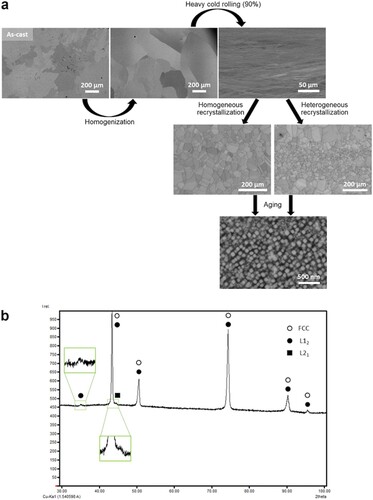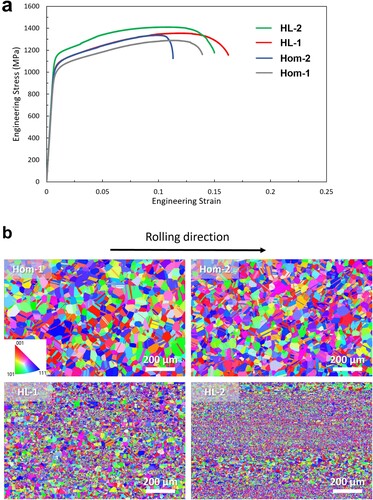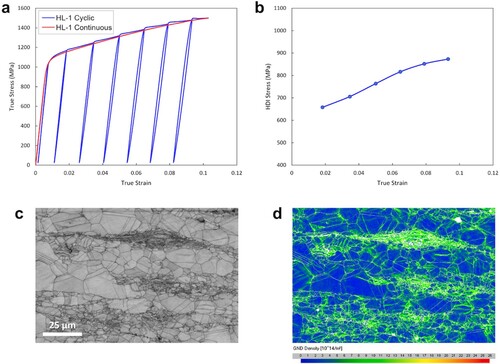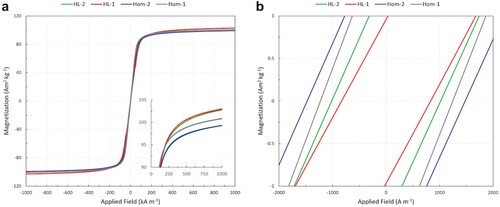Abstract
Heterogeneous lamella (HL) structures were produced via simple processing steps in a FeCoNi-based complex concentrated alloy (CCA) with superalloy-like FCC/L12 microstructure. Compared to the homogeneous-structured control specimens, the HL-structured specimens exhibited synergic enhancements in strengths and ductility (with σy up to 1 GPa, σu up to 1.4 GPa, and ϵt up to 16.5%), and at the same time, higher saturation magnetization and lower coercivity (with Ms up to 104 Am2 kg−1 and Hc as low as 833 A/m). The results obtained in this study provide insights to enhancing mechanical properties in structural soft magnetic materials without sacrificing their magnetic properties.
GRAPHICAL ABSTRACT

IMPACT STATEMENT
The current work presents a simple and effective strategy that can be applied to soft magnetic alloys with superalloy-like microstructures for simultaneous enhancements of mechanical and magnetic properties.
Introduction
The strategy of alloy design has experienced a paradigm shift since the emergence of high-entropy alloys (HEAs) in 2004. Until then, the same alloy design concept that had been utilized ever since the bronze age, had still been employed to develop modern alloys [Citation1]. Due to the compositional and property limitations of this approach (specific trace amounts of alloying elements are added to less than two principal elements), the performance improvement of traditional alloys had reached a bottleneck [Citation2]. The discovery of HEAs freed alloy compositions from the corners of phase diagrams into the vast central region and brought numerous possibilities for new alloys with novel properties. Over the past two decades, HEAs have evolved and expanded to complex concentrated alloys (CCAs) or multi-principal element alloys (MPEAs), which possess even more compositional and microstructural complexities to better meet the needs of new alloys for extreme service conditions [Citation3].
One of the typical microstructural types of CCAs that has received much research attention is the superalloy-like FCC/L12 structure [Citation4–22] due to their resemblance to the traditional Ni-based superalloys which are known for their high strength and ductility, at both room and elevated temperatures. Combining the extra strengthening effects intrinsic to CCAs [Citation23] and the intriguing properties found in the multicomponent L12 nanoprecipitates [Citation13,Citation15], as well as the numerous possibilities in compositional design, the superalloy-like CCAs have exhibited promising potential for becoming next generation structural materials. On the other hand, CCAs possessing such microstructure usually contain high concentrations of ferromagnetic elements such as Fe, Co, and Ni [Citation4–9,Citation11–13,Citation15–22], which can endow them with the potential for possessing good soft magnetic properties [Citation9,Citation11,Citation24–27]. CCAs with both good mechanical and magnetic properties are highly desirable candidates for electric systems operating under high loads such as electric motors and electromagnets [Citation9,Citation25,Citation27].
In recent years, several studies have overcome the well-known strength-ductility trade-off [Citation3,Citation28,Citation29] in strengthening the superalloy-like CCAs, including composition tuning [Citation10,Citation12,Citation15,Citation20], microstructure optimization [Citation6,Citation8,Citation19,Citation21], and utilization of heterogeneous lamella (HL) structure [Citation7,Citation14]. An HL structure is the most effective type of heterostructure in promoting strength-ductility synergy in both traditional metallic materials and CCAs [Citation30,Citation31] and have been successfully applied to multiple CCA systems [Citation7,Citation14,Citation32–38]. The high efficacy and low compositional dependency make HL structures worth further exploration in the current system. The present study has produced HL structures in a FeCoNi-based superalloy-like CCA and first examined their effects on the magnetic properties.
Materials and methods
Alloy ingots with composition of Al5Ti7(FeCoNi)86Cu2 (at. %) were produced by arc-melting of raw elements with purities over 99.9% (wt. %) under a Ti-gettered argon atmosphere. Each ingot was flipped and remelted at least 5 times to ensure chemical homogeneity. The ingots were cut into approximately 23 × 6 × 10.5 mm3 rectangular prisms by a diamond saw and homogenized at 1200°C for 2 h followed by quenching into ice water. Each homogenized section was cold rolled (parallel to the 23 mm direction) with a reduction in thickness (RIT) of ∼90% into ∼1 mm-thick sheets. The rolled sheets were then sectioned into ∼45 mm-long segments by diamond saw and annealed at different conditions for recrystallization followed by water-quenching. The recrystallized samples were aged at 825°C for 3.5 h to allow the precipitation of coherent L12 phase. Tensile specimens with gauge length of 18 mm and cross-section of 1.8 × 1 mm2 were waterjet-cut out of the heat-treated sheets and carefully ground and polished to a mirror surface. Room temperature tensile tests were performed at a strain rate of 1 × 10−3 s−1 with strain gauges attached on the specimens. At least two specimens for each condition were tested to ensure the reproducibility of the results. Additional loading-unloading-reloading (LUR) cyclic tensile tests were performed at the same strain rate for measuring the hetero-deformation-induced (HDI) stress. The magnetic hysteresis loops were measured at room temperature using a Quantum Design vibrating sample magnetometer (VSM). The measured curves were corrected through post-processing to reflect the magnetization behavior more accurately. Bulk specimens with a dimension of approximately 5 × 5 × 1 mm3 were used for the measurements.
Phase identification via X-ray diffraction (XRD) was conducted on a Rigaku Miniflex II X-ray diffractometer with Cu Kα radiation. Microstructure characterizations were carried out using a Thermo Scientific Apreo scanning electron microscope (SEM) equipped with an Oxford Symmetry CMOS electron backscatter diffraction (EBSD) detector. The average grain size and geometrically necessary dislocation (GND) density map were generated through post-processing the EBSD data using Oxford Instrument's Aztec and Tango software.
Results and discussion
a visualizes the thermo-mechanical processing route described earlier for achieving homogeneous and HL grain structures with L12 nanoprecipitation. The mechanism for forming HL structures in this type of CCA has been explained in-detail in Zhang et al.’s previous work [Citation35]. The XRD plot in b shows identification of the main phases, FCC and L12, in the material. The small peak marked by the solid square around 45 degrees matches a minor grain boundary L21 phase which has been reported by Yang et al. in similar compositional spaces [Citation15,Citation19]. More detailed phase identification information is provided in the Appedices.
Figure 1. (a) Microstructure evolution of Al5Ti7(FeCoNi)86Cu2 through thermo-mechanical processing; (b) Representative XRD spectrum of the final microstructures.

The tensile engineering stress–strain curves of the four variations of grain morphologies examined in this work are shown in a and their corresponding EBSD-inverse pole figure (IPF) maps are shown in b. As shown in the figure, there are two homogeneous grain structures (Hom-1 and Hom-2) which were recrystallized at 1100°C for 2 and 1.5 min, respectively. The two heterogeneous lamella structures (HL-1 and HL-2) were achieved by annealing at 975°C for 15 min and 1000°C for 2 min, respectively. The Hom-1 specimen possesses the coarsest microstructure (avg. grain size ∼21 µm) among the four materials and has the lowest strengths (867 ± 4 MPa yield strength and 1289 ± 1 MPa ultimate tensile strength (UTS)). The Hom-2 specimen with finer grains (avg. grain size ∼17 µm) exhibited increased strengths (924 ± 4 MPa yield strength and 1331 ± 6 MPa UTS) but also a reduction in ductility (from 14.4% ± 0.5% to 11.4% ± 0.1%), which demonstrates the typical strength-ductility trade-off due to grain refinement. On the other hand, the HL-1 specimen, having the almost same yield strength as Hom-2, was able to achieve significantly higher ductility of 16.5% ± 0.3% (even surpassed that of the Hom-1 specimen) and higher UTS of 1353 ± 3 MPa benefited from the enhanced strain hardening capability created by the HL structure [Citation30,Citation39]. Similar to HL-1, the HL-2 specimen, which possesses a finer version of HL structure than HL-1, also achieved synergic enhancements in both strength and ductility (with 1032 ± 2 MPa yield strength, 1411 ± 1 MPa UTS, and 15% ± 1% ductility) compared to the two homogeneous-structured specimens.
Figure 2. (a) Tensile engineering stress–strain curves of Al5Ti7(FeCoNi)86Cu2 with different grain morphologies and (b) their corresponding EBSD-IPF maps.

Similar mechanical behaviors have been reported and explained extensively in multiple other systems with HL structures enabled by grain size heterogeneity [Citation7,Citation14,Citation32,Citation35,Citation38–40], where the enhancement in strain hardening capability was attributed to the pile-up of geometrically necessary dislocations (GNDs) during the heterogeneous plastic deformation resulting from different regions having distinctively different grain sizes, and thus, disparate mechanical properties. Whereas in homogenous microstructures, plastic deformation is dominated by the randomly distributed, statistically stored dislocations (SSDs). The accumulated GNDs across the microstructure generate long-range back and forward stresses, collectively defined as HDI stress, which promotes strain hardening and endows the material superior mechanical properties. This special hardening process was termed HDI hardening [Citation31].
HDI stress can be verified by the loading-unloading-reloading (LUR) cyclic tensile test and calculated through interpreting the measured curve [Citation28,Citation31]. Materials with heterogeneous deformation exhibit hysteresis loops in the LUR curve, also known as the Bauschinger effect. Larger loops characterize more substantial HDI hardening [Citation28]. a shows the LUR curve generated in the HL-1 material. As can be observed from the curve, the loop becomes progressively larger with the increasing plastic strain, indicating continuously increased HDI hardening effect as the material deforms further. b shows calculated HDI stresses at different strain level using the well-recognized method derived by Yang et al. in 2016 [Citation41]. The evolution of HDI stress agrees well with the observation from the LUR curve. c,d show an SEM image and its corresponding GND density heatmap, respectively, acquired from the deformed specimen. According to the literature, the GNDs primarily forms in the soft, coarse grain region during the yielding stage of the material, which develops back stress in the soft zone and enhances the overall yield strength. Once the material has fully yielded, a forward stress develops in the hard, fine grain region due to the hetero-plastic deformation and is responsible for promoting strain hardening in the hard zone [Citation28]. This forward stress may correlate with the higher GND density observed in the hard zone after plastic deformation. The GND segregation with respect to grain size observed in d provides clear evidence of strain partitioning between coarse grain and fine grain regions, which leads to the generation of the HDI hardening effect. The results shown in correspond well with those reported in the literature [Citation7,Citation14,Citation32,Citation35,Citation39,Citation40].
Figure 3. (a) Overlay of tensile true stress–strain curves of the HL-1 specimen under normal continuous loading and cyclic loading; (b) HDI stress calculated from (a); (c) SEM micrograph of deformed HL-1 specimen and (d) its corresponding GND density map.

The magnetic hysteresis curves of the four specimens were measured to examine the effect of HL structures on the magnetic performance of materials and are presented in . According to the results, all specimens show typical soft ferromagnetic behaviors, with high saturation magnetization (∼100 Am2 kg−1 on average) and medium coercivity (∼1100 A/m on average) relative to other FeCoNi-based CCAs (typically 50–130 Am2 kg−1 for the former and 300–1500 A/m for the latter) [Citation25,Citation27,Citation43,Citation44]. As can be further observed in the inset of a, both HL-structured specimens achieved higher saturation magnetization than the homogeneous-structured specimens and are less sensitive to the change in grain size. Similarly, both HL-structured specimens exhibited lower coercivity (b), with HL-1 performing slightly better than HL-2. It has been previously reported that the magnetic properties of soft magnetic CCAs can be improved by tailoring the chemical composition or microstructure, but the improvements have either been accompanied by compromises in mechanical properties [Citation9,Citation24,Citation26,Citation42] or not been able to be realized synergically (e.g. the improvement in coercivity required sacrifice in saturation magnetization) [Citation11,Citation25,Citation27,Citation43,Citation44]. The results from this study suggest that both properties can be simultaneously enhanced (and each in a synergic way) by utilizing the HL structure with grain size heterogeneity.
Figure 4. (a) Magnetic hysteresis plots of the four specimens with the inset showing details of saturation behavior; (b) Magnified view on the center region of the plots in (a).

It has been demonstrated that the magnetic properties of superalloy-like CCAs are typically dominated by the composition of the FCC matrix and the L12 precipitates [Citation9,Citation11]. In the present study, this factor was controlled by using the same alloy composition and same aging parameters in different specimens. It has also been shown that the magnetic properties can be effectively tuned by adjusting grain size distributions [Citation45]. Therefore, the dominant variable on the magnetic behaviors in the current materials is more likely to be the different grain size distributions achieved in the recrystallization step prior to aging. For instance, in the two homogeneous-structured specimens, the finer grain size of the Hom-2 specimen compared to Hom-1 lead to lower saturation magnetization and higher coercivity due to the increased impediment of grain boundaries on the growth of domain walls [Citation9,Citation11]. However, in the HL-structured specimens that possess a finer microstructure compared to either Hom-1 or Hom-2, improvements in both saturation magnetization and coercivity have been achieved. A plausible explanation to this phenomenon is the synergic effect produced by the interactive coupling between heterogeneous zones which has been observed in many functional materials including magnetic materials, thermoelectric materials, ferroelectric materials, etc., where integrated properties can exceed properties predicted by rule-of-mixture from separate zones [Citation31]. Such synergies have been achieved in several composite magnetic materials with heterogeneous structures, but have not been reported in precipitation strengthened alloys with heterogeneity enabled by grain size variations. Therefore, more in-detail studies focusing on the magnetic behaviors in materials of this type will need to be carried out to better understand the novel behavior observed in the present work.
Conclusion
In summary, HL structures were produced in a FeCoNi-based soft magnetic superalloy-like CCA via simple thermo-mechanical processing. Compared to the specimens with homogeneous grain structure, the HL-structured specimens exhibited strength-ductility synergy and saturation magnetization-coercivity synergy, both at the same time, which has not been realized in previous studies on soft magnetic CCAs. Furthermore, the production of HL structure in this work do not require special processing steps (e.g. asymmetric rolling, extra hot rolling and/or extra annealing) and can be generalized to many other similar systems, which is particularly beneficial for CCAs that have countless compositional possibilities. Finding a generally applicable processing route for the same type of microstructure can minimize the compositional dependence of performance and significantly reduce the lead time and cost compared to extensive composition mining and validation [Citation46].
Supplemental Material
Download MS Word (1.3 MB)Acknowledgements
The authors would like to acknowledge the assistance of the following former and current colleagues at the Nanoengineering Materials Research Center, University of California San Diego: Dr. Cheng Zhang, Dr. Chaoyi Zhu, and Sabine Faulhaber, for their help with sections of the experiments conducted in this research. The authors would also like to acknowledge Professor Eric Fullerton and Biswajit Sahoo at the Center for Memory and Recording Research, University of California San Diego, for their generous assistance with the magnetic measurements conducted in this research.
Disclosure statement
No potential conflict of interest was reported by the author(s).
References
- Xiong W, Guo AXY, Zhan S, et al. Refractory high-entropy alloys: a focused review of preparation methods and properties. J Mater Sci Technol. 2023;142:196–215. doi:10.1016/j.jmst.2022.08.046
- Hua XJ, Hu P, Xing HR, et al. Development and property tuning of refractory high-entropy alloys: a review. Acta Metall Sin (Engl Lett). 2022;35:1231–1265. doi:10.1007/s40195-022-01382-x
- George EP, Curtin WA, Tasan CC. High entropy alloys: a focused review of mechanical properties and deformation mechanisms. Acta Mater. 2020;188:435–474. doi:10.1016/j.actamat.2019.12.015
- Chang YJ, Yeh AC. The evolution of microstructures and high temperature properties of AlxCo1.5CrFeNi1.5Tiy high entropy alloys. J Alloys Compd. 2015;653:379–385. doi:10.1016/j.jallcom.2015.09.042
- He JY, Wang H, Huang HL, et al. A precipitation-hardened high-entropy alloy with outstanding tensile properties. Acta Mater. 2016;102:187–196. doi:10.1016/j.actamat.2015.08.076
- Chen Y, Deng HW, Xie ZM, et al. Tailoring microstructures and tensile properties of a precipitation-strengthened (FeCoNi)94Ti6 medium-entropy alloy. J Alloys Compd. 2020;828:154457. doi:10.1016/j.jallcom.2020.154457
- Zhang C, Zhu C, Cao P, et al. Aged metastable high-entropy alloys with heterogeneous lamella structure for superior strength-ductility synergy. Acta Mater. 2020;199:602–612. doi:10.1016/j.actamat.2020.08.043
- Gwalani B, Dasari S, Sharma A, et al. High density of strong yet deformable intermetallic nanorods leads to an excellent room temperature strength-ductility combination in a high entropy alloy. Acta Mater. 2021;219:117234. doi:10.1016/j.actamat.2021.117234
- Han L, Rao Z, Souza Filho IR, et al. Ultrastrong and ductile soft magnetic high-entropy alloys via coherent ordered nanoprecipitates. Adv Mater. 2021;33:2102139.
- Yang L, Liang D, Cheng Z, et al. Simultaneous enhancement of strength and ductility via microband formation and nanotwinning in an L12-strengthened alloy. Fundam Res. 2022. doi:10.1016/j.fmre.2022.05.024
- Han L, Maccari F, Souza Filho IR, et al. A mechanically strong and ductile soft magnet with extremely low coercivity. Nature. 2022;608:310–316. doi:10.1038/s41586-022-04935-3
- Lu Y, Zhang K, Zhao B, et al. Balanced mechanical properties of Al0.3CoCrFeNiTix high-entropy alloys by tailoring Ti content and heat treatment. Mater Sci Eng A. 2023;866:144677. doi:10.1016/j.msea.2023.144677
- Zhang J, Zhao Z, Li Q, et al. Unveiling the unique bifunctionality of L1 2 -structured nanoprecipitates in a FeCoNiAlTi-type high-entropy alloy. Adv Powder Mater. 2023;2:100113. doi:10.1016/j.apmate.2023.100113
- Fan J, Ji X, Fu L, et al. Achieving exceptional strength-ductility synergy in a complex-concentrated alloy via architected heterogeneous grains and nano-sized precipitates. Int J Plast. 2022;157:103398. doi:10.1016/j.ijplas.2022.103398
- Yang T, Zhao YL, Tong Y, et al. Multicomponent intermetallic nanoparticles and superb mechanical behaviors of complex alloys. Science. 2018;362:933–937. doi:10.1126/science.aas8815
- Han B, Wei J, Tong Y, et al. Composition evolution of gamma prime nanoparticles in the Ti-doped CoFeCrNi high entropy alloy. Scr Mater. 2018;148:42–46. doi:10.1016/j.scriptamat.2018.01.025
- Kuo CM, Tsai CW. Effect of cellular structure on the mechanical property of Al0.2Co1.5CrFeNi1.5Ti0.3 high-entropy alloy. Mater Chem Phys. 2018;210:103–110. doi:10.1016/j.matchemphys.2017.10.064
- Gwalani B, Gorsse S, Soni V, et al. Role of copper on L12 precipitation strengthened fcc based high entropy alloy. Materialia. 2019;6:100282. doi:10.1016/j.mtla.2019.100282
- Yang T, Zhao YL, Fan L, et al. Control of nanoscale precipitation and elimination of intermediate-temperature embrittlement in multicomponent high-entropy alloys. Acta Mater. 2020;189:47–59. doi:10.1016/j.actamat.2020.02.059
- Zhao YL, Yang T, Li YR, et al. Superior high-temperature properties and deformation-induced planar faults in a novel L12-strengthened high-entropy alloy. Acta Mater. 2020;188:517–527. doi:10.1016/j.actamat.2020.02.028
- Li Z, Fu L, Peng J, et al. Improving mechanical properties of an FCC high-entropy alloy by γ′ and B2 precipitates strengthening. Mater Charact. 2020;159:109989. doi:10.1016/j.matchar.2019.109989
- Adil S, Suraj MV, Pillari LK, et al. On the effect of Fe in L12 strengthened Al–Co–Cr–Fe–Ni–Ti complex concentrated alloy. Materialia. 2020;14:100909. doi:10.1016/j.mtla.2020.100909
- Li W, Xie D, Li D, et al. Mechanical behavior of high-entropy alloys. Prog Mater Sci. 2021;118:100777. doi:10.1016/j.pmatsci.2021.100777
- Zuo TT, Ren SB, Liaw PK, et al. Processing effects on the magnetic and mechanical properties of FeCoNiAl0.2Si0.2 high entropy alloy. Int J Miner Metall Mater. 2013;20:549–555. doi:10.1007/s12613-013-0764-x
- Li Z, Wang C, Yu L, et al. Magnetic properties and microstructure of FeCoNi(CuAl)0.8Snx (0 ≤ x ≤ 0.10) high-entropy alloys. Entropy. 2018;20:872. doi:10.3390/e20110872
- Yang C, Zhang J, Li M, et al. Soft-Magnetic high-entropy AlCoFeMnNi alloys with dual-phase microstructures induced by annealing. Acta Metall Sin (Engl Lett). 2020;33:1124–1134. doi:10.1007/s40195-020-01086-0
- Bazioti C, Løvvik OM, Poulia A, et al. Probing the structural evolution and its impact on magnetic properties of FeCoNi(AlMn)x high-entropy alloy at the nanoscale. J Alloys Compd. 2022;910:164724. doi:10.1016/j.jallcom.2022.164724
- Sathiyamoorthi P, Kim HS. High-entropy alloys with heterogeneous microstructure: processing and mechanical properties. Prog Mater Sci. 2022;123:100709. doi:10.1016/j.pmatsci.2020.100709
- George EP, Raabe D, Ritchie RO. High-entropy alloys. Nat Rev Mater. 2019;4:515–534. doi:10.1038/s41578-019-0121-4
- Zhu Y, Ameyama K, Anderson PM, et al. Heterostructured materials: superior properties from hetero-zone interaction. Mater Res Lett. 2021;9:1–31. doi:10.1080/21663831.2020.1796836
- Zhu Y, Wu X. Heterostructured materials. Prog Mater Sci. 2023;131:101019. doi:10.1016/j.pmatsci.2022.101019
- Zhang C, Zhu C, Harrington T, et al. Design of non-equiatomic high entropy alloys with heterogeneous lamella structure towards strength-ductility synergy. Scr Mater. 2018;154:78–82. doi:10.1016/j.scriptamat.2018.05.020
- Zhang C, MacDonald BE, Guo F, et al. Cold-workable refractory complex concentrated alloys with tunable microstructure and good room-temperature tensile behavior. Scr Mater. 2020;188:16–20. doi:10.1016/j.scriptamat.2020.07.006
- Kim YK, Lee BJ, Hong SK, et al. Strengthening and fracture of deformation-processed dual fcc-phase CoCrFeCuNi and CoCrFeCu1.71Ni high entropy alloys. Mater Sci Eng A. 2020;781:139241. doi:10.1016/j.msea.2020.139241
- Zhang C, Zhu C, Vecchio K. Non-equiatomic FeNiCoAl-based high entropy alloys with multiscale heterogeneous lamella structure for strength and ductility. Mater Sci Eng A. 2019;743:361–371. doi:10.1016/j.msea.2018.11.073
- Shi P, Ren W, Zheng T, et al. Enhanced strength–ductility synergy in ultrafine-grained eutectic high-entropy alloys by inheriting microstructural lamellae. Nat Commun. 2019;10:1–8. doi:10.1038/s41467-018-07882-8
- Liu X, Zhang C, Zhu C, et al. Creating heterogeneous lamella structure in a multiphase Al-Cr-Fe-Co-Ni complex concentrated alloy. Mater Sci Eng A. 2022;858:144150. doi:10.1016/j.msea.2022.144150
- Zhang C, Wang H, Wang X, et al. Strong and ductile refractory high-entropy alloys with super formability. Acta Mater. 2023;245:118602. doi:10.1016/j.actamat.2022.118602
- Wu X, Yang M, Yuan F, et al. Heterogeneous lamella structure unites ultrafine-grain strength with coarse-grain ductility. Proc Natl Acad Sci U S A. 2015;112:14501–14505. doi:10.1073/pnas.1517193112
- Shin S, Zhu C, Zhang C, et al. Extraordinary strength-ductility synergy in a heterogeneous-structured β -Ti alloy through microstructural optimization. Mater Res Lett. 2019;7:467–473. doi:10.1080/21663831.2019.1652856
- Yang M, Pan Y, Yuan F, et al. Back stress strengthening and strain hardening in gradient structure. Mater Res Lett. 2016;4:145–151. doi:10.1080/21663831.2016.1153004
- Zhang Y, Zuo T, Cheng Y, et al. High-entropy alloys with high saturation magnetization, electrical resistivity, and malleability. Sci Rep. 2013;3:1–7. doi:10.1038/srep01455
- Li Z, Xu H, Gu Y, et al. Correlation between the magnetic properties and phase constitution of FeCoNi(CuAl)0.8Gax (0 ≤ x ≤ 0.08) high-entropy alloys. J Alloys Compd. 2018;746:285–291. doi:10.1016/j.jallcom.2018.02.189
- Lu T, He T, Zhao P, et al. Fine tuning in-sync the mechanical and magnetic properties of FeCoNiAl0.25Mn0.25 high-entropy alloy through cold rolling and annealing treatment. J Mater Process Technol. 2021;289:116945. doi:10.1016/j.jmatprotec.2020
- Lou L, Li Y, Li X, et al. Directional magnetization reversal enables ultrahigh energy density in gradient nanostructures. Adv Mater. 2021;33:2102800. doi:10.1002/adma.202102800
- Liu X, Vecchio K. Processing, microstructure evolution and mechanical property improvements of an Al–V–Cr–Mn–Fe–Ni CCA with an as-cast BCC/B2 coherent nanostructure. Mater Sci Eng A. 2022;852:143698. doi:10.1016/j.msea.2022.143698
